Redefining Rivers
Air Date: Week of November 14, 2008
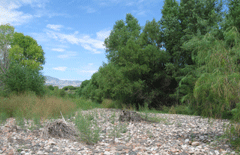
Two years ago, the Supreme Court made a landmark ruling on America's rivers that limited the reach of the Clean Water Act. The ruling has many repercussions, especially in the arid Southwest. Living on Earth’s Ingrid Lobet reports.
Transcript
GELLERMAN: And here's a geography fact I wasn't aware of: there are some rivers you can't always see because much of the time they run underground. Until two years ago, most of these seasonal waterways were protected by the Clean Water Act, but a homeowner who wanted to build on a marshy site challenged the federal restrictions and took the case all the way to the Supreme Court. The Court changed some definitions in the act, and that pleased developers - but now environmentalists are making waves. Living on Earth's Ingrid Lobet reports.
[SOUND OF VERDE RIVER]
LOBET: In a few places in Arizona, rivers sound like this:
[SOUND OF RIVER AGAIN]
LOBET: But ….more often …they sound like this:
[SOUND OF BUZZING INSECTS]
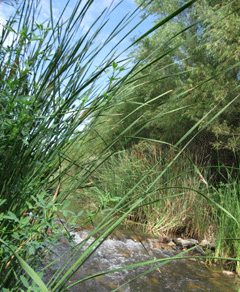
The Verde River. (Photo: Ingrid Lobet)
LOBET: This is the Santa Cruz River in downtown Tucson. The Santa Cruz runs from Arizona south to Mexico and back again, and it's dry in some months. A number of its tributaries have no water visible most of the year. Builders would like to put houses on this dry ground, but they've had to get federal permits from the Army Corps of Engineers, because the Clean Water Act protects "navigable waters." Traditionally that's meant just about all the waters of the United States. Duane Desiderio of the National Association of Home Builders says that's been a problem.
DESIDERIO: The amount of time and money that it takes to get a permit under the Clean Water Act is just inordinate. It literally takes more than a year, and adds to the cost of a house by thousands of dollars. It just has a great impact on affordable housing and the ability of ordinary folks to buy a home.

A dry riverbed of the Verde River. (Photo: Ingrid Lobet)
LOBET: So when the Supreme Court limited which ponds and waterways are protected under the Clean Water Act, builders cheered. Since then, they've been pushing the federal government to relinquish authority over some streams.
DESIDERIO: It can't be the case that the regulatory branch of the federal government should be just so intrusive that it controls every drainage ditch or water body that just becomes wet after a storm.
For southwestern environmentalists though, this tightening of the Clean Water Act is threatening. Matt Skroch is with the Sky Island Alliance in Tucson.
SKROCH: We're now seeing an incredible amount of cases where, not just in southern Arizona, but all over the West, where the Clean Water Act has been significantly undermined, with dozens and dozens of cases where they've avoided or completely circumvented any protection that would otherwise or traditionally have applied to the rivers before the Supreme Court's ruling.
LOBET: Skroch says suddenly it's unclear whether any of the rivers in his region are clearly protected.
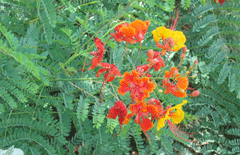
Desert flowers in bloom along the Santa Cruz River. (Photo: Ingrid Lobet)
SKROCH: It's literally every river in Arizona except the Colorado.
LOBET: There's a lot of disagreement over what's worth protecting. Paul Green, director of the Tucson Audubon Society says where a developer may see only ribbons of gravel, he sees subterranean water, rivers, the life of the desert.
GREEN: Riparian habitat are about two percent of Arizona's land area and more than 90% of the species that live here depend on those riparian areas for some stage in their life cycle. So these areas have enormous importance to wildlife.
LOBET: And some Westerners think the Supreme Court decision reflects a lack of understanding of rivers in the arid West. The decision is complex, but seems to say in order to be protected as "navigable," tributaries should have relatively permanent and continuous flow. Carolyn Campbell directs the Coalition for Sonoran Desert Protection.
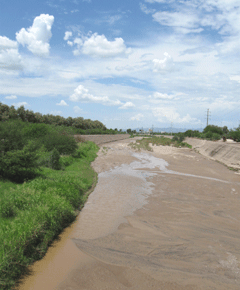
The Santa Cruz River. (Photo: Ingrid Lobet)
CAMPBELL: The Supreme Court decision made fun of the fact that the rivers in the Southwest are nothing like the "free flowing rivers" on the East Coast and the wetlands, so there is a real disconnect from people who are making the decisions, whether it is the Supreme Court or the people in Washington DC, that have a fairly laughable view of the rivers in the Southwest, the Santa Cruz River or the Los Angeles River.
LOBET: It turns out some of the rivers now losing protection are ones that people have recently been trying to reclaim. The Los Angeles River is a good example.
In the 1950s the Army Corps of Engineers encased it in concrete, because its delta flipped around like a fishtail during heavy rain, flooding local neighborhoods. Most of the year, the river would be naturally dry if it weren't for treated sewage effluent. But despite the concrete and treated waste, there's been a major campaign to save the river. Then last spring the government decided 90 percent of it no longer qualified as navigable under the Clean Water Act. Some people were incensed:
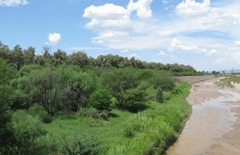
The Santa Cruz River. (Photo: Ingrid Lobet)
WOLFF: So we're here, to defend the right of the people of Los Angeles to use their own river! The city was founded where it was precisely because of the river and despite its current condition, like it or not, it is the heart and soul of the city.
LOBET: George Wolff and eleven other kayak activists set off to prove the Los Angeles River is recreationally navigable.
[SOUND OF PADDLING]
LOBET: Their journey was captured by a team that's making a documentary about the 53-mile paddle.
VOICE OF PADDLER: I'm gonna go down backwards here, looks like one person can do it, but not two - bye bye, see you later…..furious paddling….Oh, look at all these nests along here, cool!
LOBET: Three days later the paddlers climbed out - a little worse for wear, but exhilarated.
[SOUND OF PULLING KAYAKS OUT OF THE WATER, CHEERING]
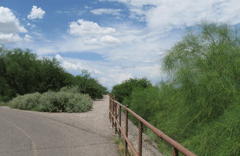
Desert trees and shrubs thrive along the Santa Cruz River. (Photo: Ingrid Lobet)
LOBET: Since environmentalists were challenging the Los Angeles River decision, and homebuilders were challenging federal jurisdiction on the Santa Cruz River, the US Environmental Protection Agency will now decide on both rivers. Benjamin Grumbles, EPA assistant administrator for water agrees the question of authority has become murkier since the Supreme Court decision.
GRUMBLES: We took over these two cases because we feel its important answer some questions to provide greater certainty for those who are looking to protect rivers and streams and understand the limits of jurisdiction under the Federal law, particularly in a desert or arid environment or a highly urban environment such as the LA River.
LOBET: Grumbles says EPA will decide the fate of the Los Angeles and Santa Cruz Rivers soon. In the meantime, 176 members of Congress have signed on to new legislation that would remove the word "navigable" from the Clean Water Act. The builders trade group is strongly opposed.
For Living on Earth, I'm Ingrid Lobet in Los Angeles.
Links
"Rock the Boat," a documentary about the L.A. River
National Association of Home Builders Comments on River Regulations
Coalition for Sonoran Desert Protection
Living on Earth wants to hear from you!
Living on Earth
62 Calef Highway, Suite 212
Lee, NH 03861
Telephone: 617-287-4121
E-mail: comments@loe.org
Newsletter [Click here]
Donate to Living on Earth!
Living on Earth is an independent media program and relies entirely on contributions from listeners and institutions supporting public service. Please donate now to preserve an independent environmental voice.
NewsletterLiving on Earth offers a weekly delivery of the show's rundown to your mailbox. Sign up for our newsletter today!
 Sailors For The Sea: Be the change you want to sea.
Sailors For The Sea: Be the change you want to sea.
 The Grantham Foundation for the Protection of the Environment: Committed to protecting and improving the health of the global environment.
The Grantham Foundation for the Protection of the Environment: Committed to protecting and improving the health of the global environment.
 Contribute to Living on Earth and receive, as our gift to you, an archival print of one of Mark Seth Lender's extraordinary wildlife photographs. Follow the link to see Mark's current collection of photographs.
Contribute to Living on Earth and receive, as our gift to you, an archival print of one of Mark Seth Lender's extraordinary wildlife photographs. Follow the link to see Mark's current collection of photographs.
 Buy a signed copy of Mark Seth Lender's book Smeagull the Seagull & support Living on Earth
Buy a signed copy of Mark Seth Lender's book Smeagull the Seagull & support Living on Earth

